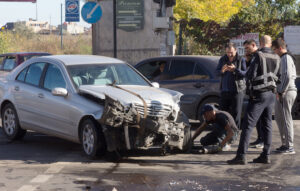Most people understand why it is important to determine who caused a car accident. Generally, the party at fault has legal liability to others for the damages the accident caused.
Understanding the importance of “fault” and figuring out who hit you, however, are two separate things.
How can you tell who hit you and, by extension, who has legal liability to you for your injuries and losses?
Read on to find out.
To figure out who hit you, lawyers, police officers, and insurance adjusters look at evidence, by which we mean the body of provable facts that flow from the accident. Every accident, from a simple rear-end collision to a massive, multi-car pileup, has the potential to generate a boatload of evidence. The trick is to know how to sort through that haystack of information to find the important needles that will prove who hit you. Below, we discuss some of the types of evidence that provide clues to what happened.


In some cases, damage to the vehicles involved in the accident clearly shows which car hit the other. Vehicle damage can indicate, among other things, the relative speed and direction of travel of the vehicles at the moment of impact, whether and how a driver attempted to avoid the impact, and sequence of impacts (what came first, second, third, etc.).
In a rear-end collision, for example, extensive damage to the rear of the vehicle will often reflect that the driver of the trailing car slammed into the rear of the leading vehicle at high speed without braking. Damage to the front of one vehicle and the side of the other indicates a T-bone collision and may point to fault. And so on.
Often, the police will evaluate damage to the vehicles at the scene of the accident and, potentially, take photographs of vehicle damage. However, the more evidence the better. If you can take photographs or video of your own at the accident scene safely and without getting in the way of first responders, then do it. There is no such thing as too many images of damage to vehicles. Every photograph or video provides potentially crucial information to investigators and accident reconstruction experts, pointing to who hit you.
Often, statements from the drivers involved in the accident, and witnesses to it, paint a vivid picture of how the accident occurred. But beware: some people may give inaccurate statements innocently, and others will lie to escape fault for the accident.
Now, we know you would not lie. However, even when people try to tell the truth to the best of their abilities, they can make statements that unintentionally mislead the interviewer or confuse the facts. For example, many people make offhand remarks that could seem to accept a portion of the responsibility for an accident, such as by saying “He came out of nowhere!” or “I should have braked sooner!” or, simply, “I’m so sorry!”
Try your best to avoid saying those sorts of things to anyone at the accident scene. Give a statement to the police that sticks to the facts as you remember them, and does not accept blame or to lay it on someone else.
Here is a little known fact: Statements of people trying their best to describe what happened in an accident will, more often than not, vary quite widely. Police understand this, which is why they do not merely stop at taking statements in preparing a police report, but instead also take photographs and record other information that might point to who hit you.
Lawyers understand it, too, which is why they always want to put witness statements in context. The witness’s perspective on the accident—their point of view, their role, their actions before and after—all come into play in figuring out the truth.
Two other important facts about witness statements to keep in mind: in most (but not all) circumstances, the accuracy of witness statements declines rapidly over time, and one person’s statements about their memories can alter another person’s memories. That is why police officers, lawyers, and insurance adjusters need to gather witness statements as soon as possible. With every day that passes, the chances increase of a memory fading or becoming corrupted by someone else’s perspective.
In this day and age, video footage has emerged as a potent and increasingly common means of determining who hit you in a car accident.
Unsure of who hit you in a car accident? Contact an attorney as soon after your accident as possible to give yourself the best chance of figuring out who was at fault and of recovering the compensation you deserve.
Benson & Bingham Accident Injury Lawyers, LLC
626 S 10th St
Las Vegas, NV 89101
702-382-9797
Benson & Bingham Accident Injury Lawyers
Summerlin Location
11441 Allerton Park Dr #100
Las Vegas, NV 89135
Phone: 702-684-6900
Fax: 702-382-9798
Downtown Location
626 S 10th St
Las Vegas, NV 89101
Phone: 702-382-9797
Fax: 702-382-9798
Henderson Location
9230 S Eastern Ave #155
Las Vegas, NV 89123
Phone: 702-463-2900
Fax: 702-382-9798
Reno Location
1320 E Plumb Lane Ste A
Reno, NV 89502
Phone: 775-600-6000
Fax: 702-382-9798
Joseph L. Benson II, and Ben J. Bingham, Personal Injury Attorneys